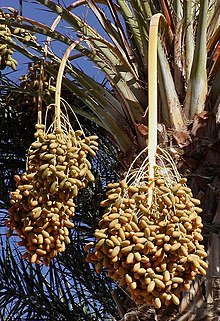Date sugar

Date sugar is a type of sugar found most commonly in natural food stores since it is less processed than more conventional sugars. It is made from dried dates and adds a rich sweetness to recipes, although it will not dissolve when added to drinks. It also does not melt like granulated sugar which can limit its use. It is sometimes promoted as a healthier alternative to brown sugar, although it can be quite expensive. Date sugar is derived from the whole date fruit; therefore can be called a whole food. The sugar content of a date consists of equal parts fructose and glucose (two common monosaccharides), with the remainder made up of sucrose.[1]
Date sugar should not be confused with date palm sugar, also called palm sugar, as this is made from the sap of the sugar palm tree, including date trees.[2][3][4] Date sugar is made from the date palm plant, date sugar is a less refined sugar than typical white sugar. Date sugar can be substituted in many foods and beverages.[5][6]
Production
Date powder is made by first making a paste from raw dates. Then, the paste is mixed with a substance called maltodextrin (a common food additive). This mixture is oven dried and ground into granules. The proportion of maltodextrin to date paste determines the properties of the sugar.[5] There are many recipes for making date sugar at home, but it can also be purchased. There are many methods looking to automate the process of date sugar production.
Dates have a few stages of development: khalaal, rutab, and tamr. The best dates to make into date sugar are tamr dates, as they have a very low moisture content (about 30%) and are very sweet.[7] Studies are currently in progress on how best to determine sugar content of a date. This could help identify the best dates to use for date sugar.
References
- ^ Fadel, Moustafa A. (2008). "Sugar Content Estimation of Date (Phoenix dactylifern L.) Fruits in Tamr Stage". Agricultural Engineering International: CIGR Journal. ISSN 1682-1130.
- ^ Firsker, Rebecca (4 January 2019). "Are Coconut Sugar and Date Sugar 'Healthy' Sugars?". Extra Crispy. Retrieved 29 April 2019.
- ^ The Healthy Homee Conomist, Why Date Sugar Rivals Honey as the Healthiest Sweetener, by John Moody Feb 15, 2019
- ^ What’s Date Sugar, and How Do You Use It? by Meghan Splawn
- ^ a b Sablani, Shyam S.; Shrestha, Ashok K.; Bhandari., Bhesh R. (1 August 2008). "A new method of producing date powder granules: Physicochemical characteristics of powder". Journal of Food Engineering. 87 (3): 416–421. doi:10.1016/j.jfoodeng.2007.12.024. ISSN 0260-8774.
- ^ Amerinasab, Asal; Labbafi, Mohsen; Mousavi, Mohammad; Khodaiyan, Faramarz (1 October 2015). "Development of a novel yoghurt based on date liquid sugar: physicochemical and sensory characterization". Journal of Food Science and Technology. 52 (10): 6583–6590. doi:10.1007/s13197-015-1716-4. ISSN 0022-1155. PMC 4573096. PMID 26396404.
- ^ Fadel, Moustafa A. (2008). "Sugar Content Estimation of Date (Phoenix dactylifern L.) Fruits in Tamr Stage". Agricultural Engineering International: CIGR Journal. ISSN 1682-1130.